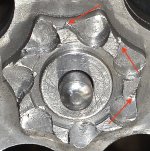andyo5
Member
I have a new 686+ that went back to the factory a few months ago because it had a bad extractor. The ratchets were poorly machined. Whoever worked on it replaced the extractor with a different one. What I am finding now is that the extractor rod and extractor appear stuck together. I cannot separate them.
My procedure is to clamp the extractor rod in a vice, using wooden blocks to protect it from damage. Load seven empty cases into the cylinder, and try to turn the cylinder clockwise (due to reverse threads). The extractor rod always turns with the cylinder, no matter how much I tighten the vice.
So far, no damage to any of the parts. But I am reluctant to try and use more extreme measures.
Is my method correct? I think it is.
Is there something I have overlooked?
Thanks!
My procedure is to clamp the extractor rod in a vice, using wooden blocks to protect it from damage. Load seven empty cases into the cylinder, and try to turn the cylinder clockwise (due to reverse threads). The extractor rod always turns with the cylinder, no matter how much I tighten the vice.
So far, no damage to any of the parts. But I am reluctant to try and use more extreme measures.
Is my method correct? I think it is.
Is there something I have overlooked?
Thanks!

